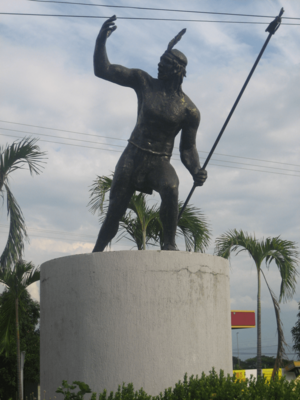Chimila people facts for kids
The Chimilas (also known as Ette Ennaka) are an indigenous people who live in northeastern Colombia. Their language, called Chimila language, is part of the Chibcha language family. In 1998, about 1,000 people spoke the Chimila language.
When the Spanish arrived, the Ariguaní River valley was a very important area for the Chimilas. The Yukpas people, who lived in the Serranía del Perijá mountains, were also part of the Chimila group of tribes.
Life Before the Spanish Arrived
Before the Spanish arrived, the Chimilas lived in most of the Cesar River basin and its valley. This area included Valledupar in the Cesar Department. Their land was located between the Sierra Nevada de Santa Marta and the Serranía del Perijá mountains, and it bordered the Magdalena River.
A Chimila leader, known as a cacique, gave his name to the city of Chimichagua, Colombia. Another powerful leader, Upar, gave his name to Valledupar. The Spanish called it "valley of Upar." The name "Cesar" for the Cesar River and Cesar Department comes from the Chimila word Chet-tzar or Zazare, which means "calm water."
The Chimilas had two main cities. One was called Thamara (now Tamalameque) and the other was Upari, named after their strong chief, cacique Upar. Spanish writers described Thamara as a very large city with over a thousand huts.
Chimila society had different groups of people. There were fishers, hunters, artists, miners, goldsmiths, and merchants. The Chimilas also had a social structure where different groups had specific roles, and some, like the Arhuacos, were part of their labor force.
The Chimilas believed in an immortal figure named Masirguta. They also believed in one main god called Narayajana (sometimes called Yao).
Music was important to the Chimilas. They used drums of many sizes and flutes with wax tips that had two to five holes. They also had an instrument called a guacharaca, which copied the sound of rufous-vented chachalaca birds. They also played maracas.
The Chimilas were skilled farmers. They grew maize (corn) very well. They also grew other local vegetables and fruits for food. They planted certain trees near their huts to create shade and keep their homes cool. The Chimilas also harvested Gynerium sagittatum, a type of cane used to make bows and arrows.
Spanish Arrival and Later Years
Around 1720, the Chimilas began fighting against the Spanish Empire. This fighting continued for a long time, even into the 20th century. In 1990, a special area called Issa Oristuna was created for the Chimila people.
See also
 In Spanish: Chimilas para niños
In Spanish: Chimilas para niños


